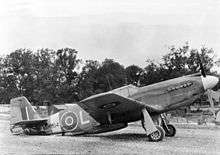No. 268 Squadron RAF
| No. 268 Squadron RAF | |
|---|---|
| Active |
1918–1919 1940–1945 1945–1946 |
| Country | United Kingdom |
| Branch | Royal Air Force |
| Motto(s) | Adjidaumo |
No. 268 Squadron RAF was a Second World War Royal Air Force squadron that operated the North American Mustang on missions over occupied Europe and in support of the D-Day landings.
History

The squadron was formed in August 1918 at Kalafrana, Malta from No. 433 and 434 Flights of the Royal Naval Air Service operating the Short 184 and Short 320 torpedo carrying floatplanes. It operated patrols in the Mediterranean until the end of the First World War and was disbanded on 11 October 1919.
On 30 November 1940 the squadron reformed at RAF Bury St. Edmunds with the Westland Lysander. It first flew anti-invasion sorties along the English coastline but the primary role was tactical reconnaissance. The squadron deployed to RAF Penshurst from 4 to 8 August 1941. It started operations with the Curtiss Tomahawk in October 1941 but these were replaced in April 1942 with the more capable North American Mustang. It converted to the Hawker Typhoon FR IB in July 1944 and continued to support the D-Day landings with tactical reconnaissance sorties.
Built in small numbers, the FR IB was intended for photo-reconnaissance at very low level. One of the Typhoon's four cannon was removed and three F24 cameras were fitted in its place, one 14-inch (360 mm) camera pointing forwards and two vertical 5-inch (130 mm) cameras. However, although the Typhoon well regarded as a combat aircraft, the reconnaissance variant was unpopular with pilots and unsatisfactory in use as inherent engine and airframe vibrations invariably blurred the photographs.
As with many RAF squadrons, 268 Squadron was manned with pilots from a wide range of backgrounds, in part due to programs such as the British Commonwealth Air Training Plan. In September 1944, half its pilots were Canadian, with others from Trinidad, Australia, Malta, Scotland and Wales; later in the year Polish and Indian pilots were transferred in.[1]
The Typhoons were replaced by Mustang MkII aircraft by Nov 1944. A further change in aircraft was effected in Sept 1945 when the Mustangs were replaced by Supermarine SpitfireXIV's. The squadron acquired Spitfire IXs from 16 Squadron only to be disbanded on 19 September 1945 when it was re-numbered to 16 Squadron.
Shortly afterwards on 26 October 1945 the former 487 Squadron was re-numbered as 268 Squadron. Based at Cambrai/Epinoy it was equipped with the twin-engined de Havilland Mosquito FB6 for use in the light bomber role before being finally disbanded on 31 March 1946.
Aircraft operated

| Dates | Aircraft | Variant | Notes |
|---|---|---|---|
| 1918–1919 | Short 184 | Single-engined torpedo seaplane | |
| 1918–1919 | Short 320 | Single-engined torpedo seaplane | |
| 1940–1942 | Westland Lysander | II and then III | Single-engined liaison |
| 1941–1942 | Curtiss Tomahawk | IIA | Single-engined fighter |
| 1942–1944 | North American Mustang | I then IA | Single-engined fighter |
| 1944 | Hawker Typhoon | FR IB | Single-engined fighter |
| 1944–1945 | North American Mustang | II | |
| 1945 | Supermarine Spitfire | XIVe and XIX | Single-engined fighter |
| 1945–1946 | de Havilland Mosquito | VI | Twin-engined light bomber |
References
Citations
Bibliography
- The Illustrated Encyclopedia of Aircraft (Part Work 1982–1985). Orbis Publishing. 1985.
- Jefford, C.G. (1988). RAF Squadrons. Airlife Publishing Ltd. ISBN 1-85310-053-6.
External links
| Wikimedia Commons has media related to No. 268 Squadron RAF. |
